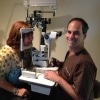
Two years ago Pamela’s vision was 20/400.
What this means in plain English for all of us is that Pamela was considered blind according to the American Medical Association’s definition of blindness (any central visual acuity of less than 20/200).
She could not read her emails and ended up not being able to drive. She had to hire a driver and even had to hire someone that could read her emails for her at work.
Pamela got to the point where she couldn’t even walk down a flight of stairs because she had no depth perception.
She stopped painting. She stopped riding horses. She said she would try to memorize things that she knew would start to disappear with her vision problems. The thought of looking at something you love and closing your eyes to memorize what it looks like for the future when you can’t see it anymore is simply terrifying.
Pamela was diagnosed with conditions called Ectasia and Pellucid.
When she underwent Corneal Collagen Crosslinking (“CXL”) with Dr. William Trattler at our center two years ago, Pamela was in fear of not being able to see her favorite things again. Two years after CXL in both eyes, she can see 20/40 with glasses, and 20/20 with scleral lenses (specialty contact lenses)!
Talk about a success story.
Corneal Collagen Crosslinking is a procedure that has been approved in Europe for over 12 years. In the United States, the FDA has been allowing certain sites to run a clinical trial in order to gain approval here. Our center is one of those cites and Dr. William Trattler has been involved in CXL since the early US trials 5 years ago.
Crosslinking is an outpatient procedure performed in our surgical laser suite. During this study, the surgeon uses an ultraviolet light and vitamin eye drops to treat the cornea (front of the eye). Vitamin eye drops are instilled in the eye and the patient is asked to look at an ultraviolet light while lying comfortably in a reclining chair.
A little background: The cornea is the clear membrane that covers the colored part of the eye and pupil. The cornea is the “window” of the eye and is the most powerful lens in the eye as well. Keratoconus is a corneal disease that causes structural changes within the cornea causing the cornea to thin and bulge outward into a steeper, irregular, more conical shape than its normal gradual curve. Please visit our Keratoconus page for more information on this condition.
Goal: CXL is an investigational treatment for patients that have been diagnosed with either Keratoconus or Post Lasik Ectasia (corneal thinning after refractive surgery). Many patients with these corneal diseases end up needing corneal transplants and the goal of this treatment is to avoid the need for a corneal transplant in these patients. Crosslinking (CXL) has been shown to increase the number of corneal crosslinks within the cornea. These links are like the natural anchors in the cornea and are responsible for preventing the cornea from bulging outwards and becoming steep and irregular. The goals of crosslinking are to stop the progression of keratoconus, decrease the severity of the corneal bulging, and allow the patient to continue or resume contact lens wear. By decreasing the severity of the corneal bulging, doctors are better able to fit the patient for contact lenses. Although the goal of the treatment is to stop the progression of the corneal disease, we are happy to report that some patients notice improvements in their vision. Every patient is different, visual results may differ.
Dr. Trattler worked in conjunction with Dr. Edward Boshnick to help fit Pamela with the right scleral lenses in order to get her to see 20/20 post CXL. Dr. Boshnick is truly a master of the art of specialty lenses and patients from around the world come to see him with corneal issues. We thank him for his help with Pamela and with all of our other keratoconus/ectasia/post-crosslinking patients. Please click here to visit his website.
Study Parameters: You may be eligible for this study if you are of age and have been diagnosed with Keratoconus or diagnosed with Corneal Ectasia after refractive surgery (e.g. LASIK, PRK). There are specific inclusion and exclusion criteria that patients must meet in order to be considered participants in the clinical trial. We will be happy to discuss these with you. Please visit our CXL website for more info.
The doctors that are currently providing CXL at our center are Dr. William Trattler, Dr. Charles Kaiser, and Dr. Gaston Lacayo.
If you or a loved one has been diagnosed with keratoconus, post lasik ectasia and/or pellucid, please contact our Refractive Surgery Coordinator, Angela, at 305-598-2020 ext. 1086. We will be happy to answer any questions you may have regarding this study and we can schedule you for an evaluation with one of our Corneal Crosslinking specialists.

